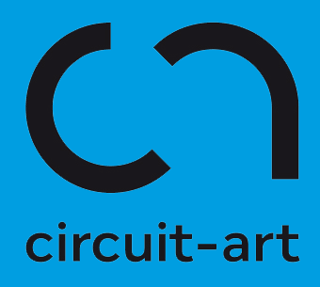Kästrich – Mainz 1990–1999
Kästrich wurde 1990 von Daniela Kieß und Harald Kubiczak gegründet. Der erste Standort war ein zufällig gefundener, verlassener Tabakladen in der Straße namens Kästrich. 1992 zog der Kästrich innerhalb desselben Viertels in einen anderen verlassenen Laden, und eröffnete dort neu mit einer Installation von Jerry Hunt. An dieser Stelle fanden bis 1999 insgesamt 30 Ausstellungen, Konzerte und andere Aktivitäten statt.
Unter dem Titel observation publizierte der Kästrich 1992/93 zwölf Ausgaben mit Beiträgen von Künstlerinnen und Künstlern.
Am Programm des Kästrich waren mehr als 70 Künstlerinnen und Künstler beteiligt. Während seines Bestehens erhielt der Kästrich keinerlei öffentliche oder private Förderungen. Der Kästrich stand in regem Austausch mit anderen Institutionen und Initiativen wie Het Apollohuis (Eindhoven) und Experimental Intermedia Foundation (New York und Gent), was die Grundlage war für viele realisierte Ausstellungen.
Kästrich was found in 1990 in Mainz by Daniela Kieß and Harald Kubiczak. The first location was an abandoned tobacco store in the street named Kästrich, found by incident. In 1992 it moved to another abandoned store within the same neighborhood and re-opened with an installation of Jerry Hunt. There, altogether more than 30 exhibitions, concerts and other events could be realized until 1999.
In 1992/93, Kästrich published 12 editions of a monthly artists' magazine called observation.
Within the program of Kästrich more than 70 artists were participating. Throughout its existence, Kästrich did not receive public or private funding to realize the program. Kästrich kept constant exchange with other institutions and initiatives such as
Het Apollohuis (Eindhoven) and
Experimental Intermedia Foundation (New York and Gent) which was the basis of many exhibitions being realized..
Rolf Langebartels
Fallen
09.04.–17.05.1999
Five sound sculptures with suspended ceramic bowls dropping on circular metal plates. Small motors are winding the bowls upwards to repeat the process. Interruptions are caused by the sounds of the single sculptures or loud sounds from the surrounding.

Dan Senn
Now and Then
18.09.–07.11.1998
Pendulum-based instruments (Tooned Penduling, Simple Pendulyre) and a site-specific installation of a Canopy Lyre. Special audio CDs with frequencies below listening trigger loudspeakers, equipped with nylon threads and small wooden hammers, hitting steel strings. Additional audible sound signals on the CDs can be heard in the surrounding of the instruments.
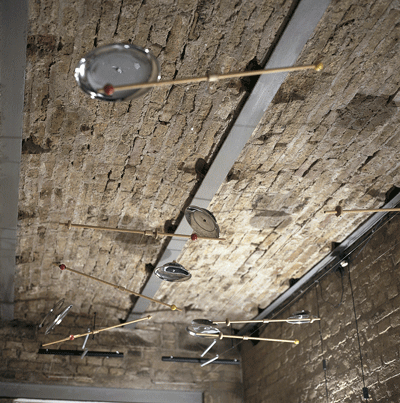
Ad van Buuren
Change Machine
20.03.–09.05.1998
Sound sculpture of components of telephone switch boards as timers and relays in two segments (1st with 15 timers and 142 relays directing the 2nd segment with nine relays and nine small hammers and bells)—all parts interconnected with a system of wires; constantly and randomly changing sound structure and rhythm.

Jacoba Bedaux & Relly Tarlo
Soundcarpet
31.10.1997–05.01.1998
Two parted sound installation to be walked on. Iron frame constructions with different segments, filled with diverse materials. Front room: pistachio shells, quartz debris and small wooden sticks. 2nd room: flattened drinking cans, broken glass and mirror, straws, plastic bags filled with dry leafs.
Michael Delia
Recyclephonic Musings
25.01.–08.03.1997
Sound sculpture constructed of thrown away everyday objects. An oscillating electric fan is constantly blowing air towards the objects, their movement causes them to hit each other producing gentle percussive sounds.

Paul van den Nieuwenhof
Langzame Sculpturen
07.12.1996–18.01.1997
Kinetic sculpture with stripes of heavy soft paper attached around a mobile ring structure. From above tinted water is constantly dripping on one point of the paper, which eventually is disturbing the equilibrium of the construction which causes an abrupt and fast rotation of the ring structure.

Ed Osborn
Wish You Were Here
07.09.–05.10.1996
Twelve loudspeakers attached to the walls, connected to a number of portable audiotape players that play fragmented sounds and noises resulting in a changing spacial net of sound sources and sound properties.
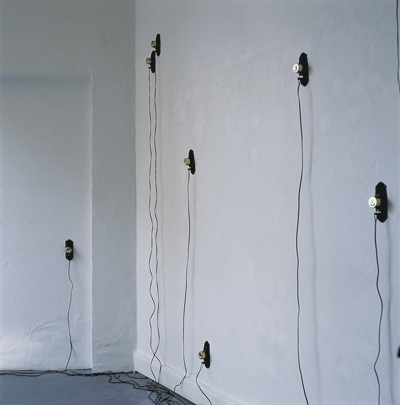
Thomas Hannibal
Raum – Thomas Hannibal
04.05.–15.06.1996
Six small paintings on different positions in both rooms, exploring relationships of image, space and viewer.
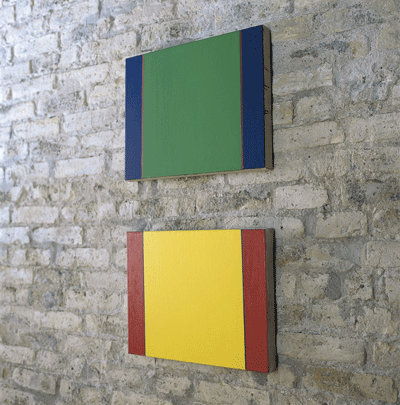
Anke Schulte-Steinberg
Situationsgebunden
25.11.1995–13.01.1996
Two shadow machines using mechanical parts of car wipers, steel and small light bulbs drawing slowly moving shapes of light and shadow on walls, ceiling and floor.
More on Anke Schulte-Steinberg …

Jens Brand
Kästrich möbliert
20.05.–01.07.1995
Installation of a drawing with bedroom closet placed in front. 2nd room: installation of a living room closet with glass cabinet and glass shelfs with glass objects; a loudspeaker with frequencies beyond hearing causes the objects to vibrate with varying sound of shaking glass.
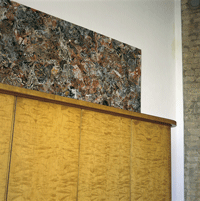
Ronald Medema
Open Mind
28.01.–04.03.1995
Chicken Paintings: three canvases that had been placed in chicken cases for some time. Two chairs made from found pieces of wood are placed in front.

Daniela Kieß
Sphinx im System der Zeichen
19.03.–23.04.1994
18 small square paintings of dense texture of layers of color installed at different positions on the walls. 2nd room: four photographs taken in Russia by Kieß’ grandfather during World War II., reproduced as blow-ups and dyed with layers of transparent ink.
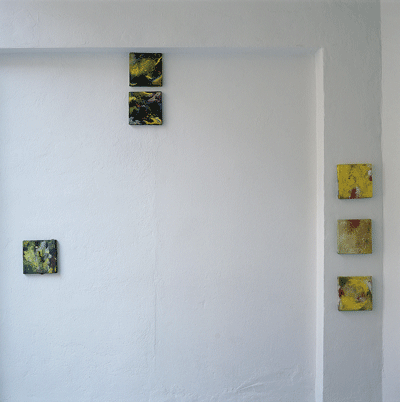
Bruce Checefsky
Photograms
27.11.1993–15.01.1994
Large scale photograms of a great number of found objects, that were placed directly on photo paper and exposed with multiple soft flash lights.

Mona Higuchi & Richard Lerman
Night of the Broken Glass
10.10.–13.11.1993
Two-parted installation of about 3000 small right angular pieces of glass, suspended from segments of the ceiling with nylon threads. Small electric fans blow a flow of air, causing the glass to constantly move; sound of the glasses hitting can be heard.

Phill Niblock
Sumatra for Kästrich / Wall Hangings
05.06.–17.07.1993
Screening of the film Sumatra, taken in pastoral environments, showing everyday work as a weaving mill or a forge.
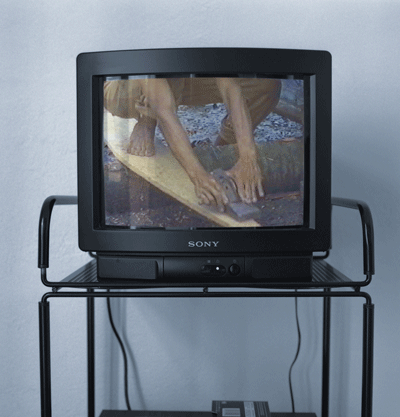
Nico Parlevliet
Eating Potatoes
13.03.–17.04.1993
Sound sculpture in an iron construction with metal table-like surface with three forks sliding, driven by the mechanics of a wind shield wiper. Water is poured from a small hose into a bowl and bucket below.

Harald Kubiczak
Tremolo
13.03.–17.04.1993
Sound sculpture with six mouth harps of different tuning and type mounted on electric blowers.
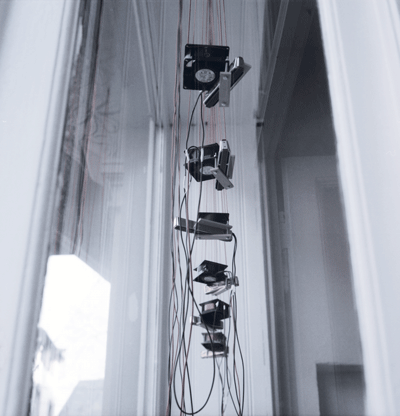
Paul Panhuysen
Mechanical Long String Guitars
19.12.1992–30.01.1993
Installation of six electric guitars, on the ceiling. Long steel strings attached to the strings of each guitar and stretched to six points below the window. Six fast turning electric motors equipped with wire plectrums are hitting the strings. Amplification via guitar amps.

Jerry Hunt
Surface (room) : ()
20.09.–07.11.1992
Installation of a square frame with 5x5 square grid on the ceiling with various arte facts and tiny bells suspended. Electric fans on the floor cause the objects to move slowly. Microphones are hanging inside the installation, low amplification of the acoustic sounds.
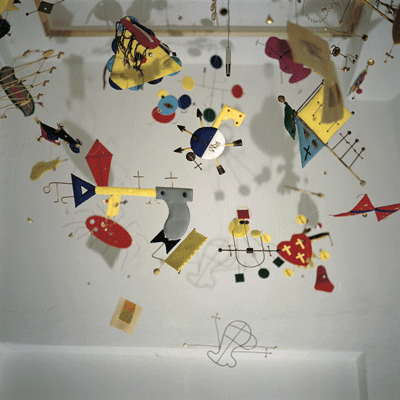
Paul Panhuysen
Requiem for an Unknown Soldier
08.–29.06.1991
Sound installation of four portable organs that were used by the French army in World War II, driven by electric motors. Tuning of the organs is determined on calculation formulas, one is playing four notes simultaneously and continuously, three are are playing four different notes simultaneously with short intermissions. Timer is performing in cycles of two minutes.
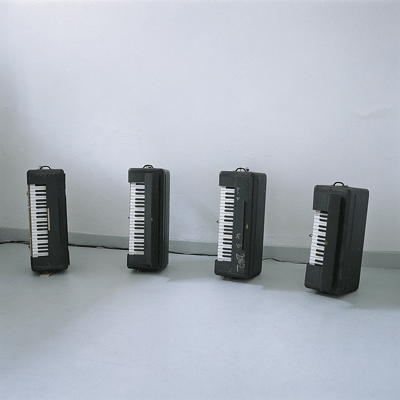
Johan Goedhart
Gelb, Blau, Rot und Grün
06.04.–27.04.1991
Sound sculpture with electric magnets attached to the bottom of four identical metal cans.

Roland Siegrist
15.–30.1.91
02.02.–02.03.1991
15 black and white silk screen prints on paper, printed between Jan 15 and 30, 1991, the days of the 1st gulf war – each day one print was made.

Harald Kubiczak
Bücherwand
01.–29.12.1990
Installation of about 3,600 books of a former loan library of the nineteen-fifties.

